text and photos by Phil Armstrong
Originally published on PhilArmstrongArt. com
“The city of Cincinnati was one of the pioneers, in these United States, in securing ‘pure water’ for its inhabitants.”
-Bert L. Baldwin, The Rotarian (Nov. 1914)
It was March, 1930. A special report filed to the City Manager by the General Superintendent of the Cincinnati Waterworks stated the Western Hills pumping station on Queen City Avenue was in dire need of increasing capacity due to the large growth in population of the surrounding area. Built in 1907, the station was operating at max capacity and needed to expand. For the next five years, those in charge planned for a new set of pumps, arguing about whether they should be steam or electric, in a new building to take over operation of the old station. The Cincinnati Enquirer constantly changed their headlines when reporting management’s decision about installing steam or electric pumps.
Finally, by 1934, the new station was decided to be built next door to the old one and management settled on using electric pumps after years of financial analysis was done. By November of that same year, Joseph G. Steinkamp was locked down as architect. Fifty men making fifty five cents an hour were planned for a year of construction to build the new station.

Apparently it took longer than a year to build. Upon completion in 1937, the new Western Hills Pumping Station at 1650 Queen City Avenue was dubbed “the most modern in the United States” and was built at a cost of $312,000. The station featured considerably smaller pumps than its predecessor. According to the Cincinnati Enquirer from December, 1937, “much of the credit for the construction of the plant…goes to Charles H. Anderson of the Waterworks Department, who drew all plans and specifications for the pumping and control equipment.” Anderson was held on as a consultant by city officials to assist with the construction project even though he had retired two years prior at the age of seventy.
Two years and eight months later, after seemingly being forgotten for a bit, the building was finally dedicated by Mayor James G. Stewart in a all-too-brief ceremony. Only five minutes into the mayor’s speech, rain started pouring down on the masses who were standing on the lawn, scattering everyone to nearby shelter. Ironically, the waterworks pumping station dedication was foiled by copious amounts of water it couldn’t control despite its thousands of dollars of machinery.
In the coming years, news of the new Western Hills Pumping Station grew less frequent. One story involved an effort by the city manager to make a private drive next to the pump station a public street so police officers could patrol it. His reason? “Indiscriminate petting” by people parking and committing “other nuisances detrimental to public interest.” Apparently the city manager wasn’t a fan of teenagers making out in their cars.
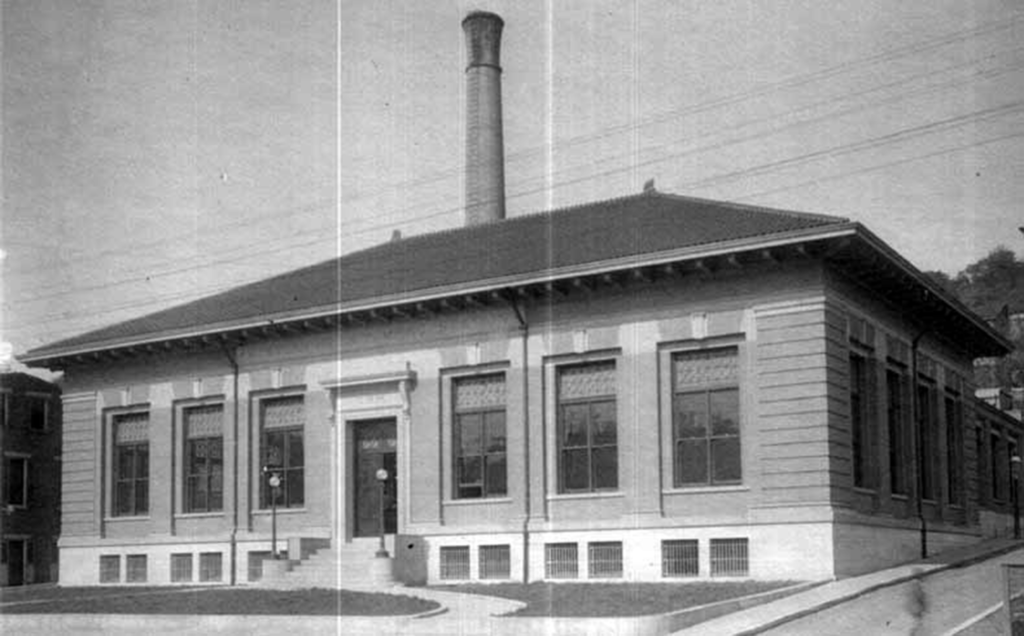
News of the old pumping station made obsolete by the new one started appearing in the Enquirer again in early 1942. The city manager began raising the issue of demolishing the old station so scrap could be salvaged and donated to the war effort. A petition numbering 1,320 people protesting the destruction of the old pumping station made its way to City Council. Their idea was to turn the old station into a recreation center, but their pleas fell on deaf ears. By August of 1942, a contract for $7,525 was awarded to Gus Goldman and James A. Dray of the Globe Wrecking Company to demo and salvage scrap from the old station. Preservation efforts had failed.
Occasionally news about the new station would appear in the paper, but it was generally forgotten as pump stations normally are, left to do their work without further celebration. Fast forward to 2016, and my own personal adventure to rediscover this nearly eighty year old Art Deco gem began on a chilly Saturday morning in February.
Matt Deininger and I met up on the Square beside the currently-dry Tyler Davidson fountain, known colloquially as the Genius of Water. It was a symbolic gesture, one that escaped my comprehension until reflecting on our morning later that day. Our plan was to walk to the Western Hills Pumping Station to get a tour from Larry Moster, the Greater Cincinnati assistant treatment superintendent. Matt had orchestrated the meeting and was kind enough to invite me along to see it with him, so with a camera bag on my shoulder and a tripod in hand, we made our way up Central Parkway to Harrison and crossed the viaduct into South Fairmount. It was about three and a half miles and the walk was pleasantly sunny.
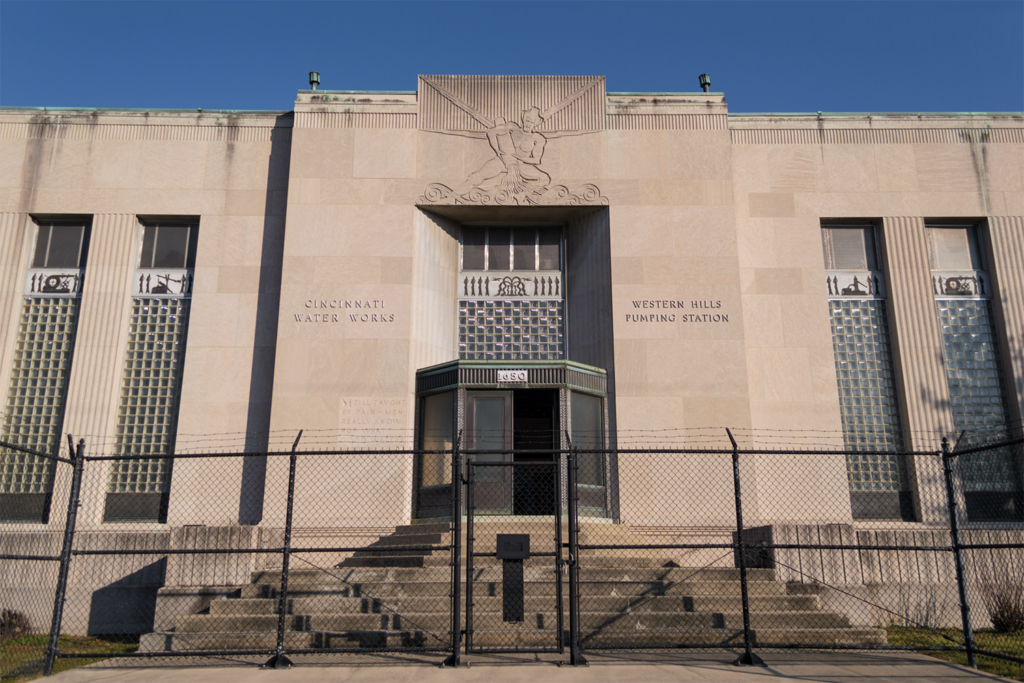
When we arrived, we checked out the station from the hill behind it. Its jaded copper roof beamed brilliantly under the morning sun from behind a chain link barbed wire fence keeping us at a distance. We moved toward the front and took some establishing shots while marveling at the work architects Joseph Steinkamp and his brother, Benjamin, had done eighty years ago. The Steinkamps designed a plethora of iconic Cincinnati structures in the basin, including The Waldo and The American Building, and they certainly didn’t regard the pump station as any less of a project. For a utilitarian construct, it’s absolutely incredible what government-funded money would buy you during the WPA years.
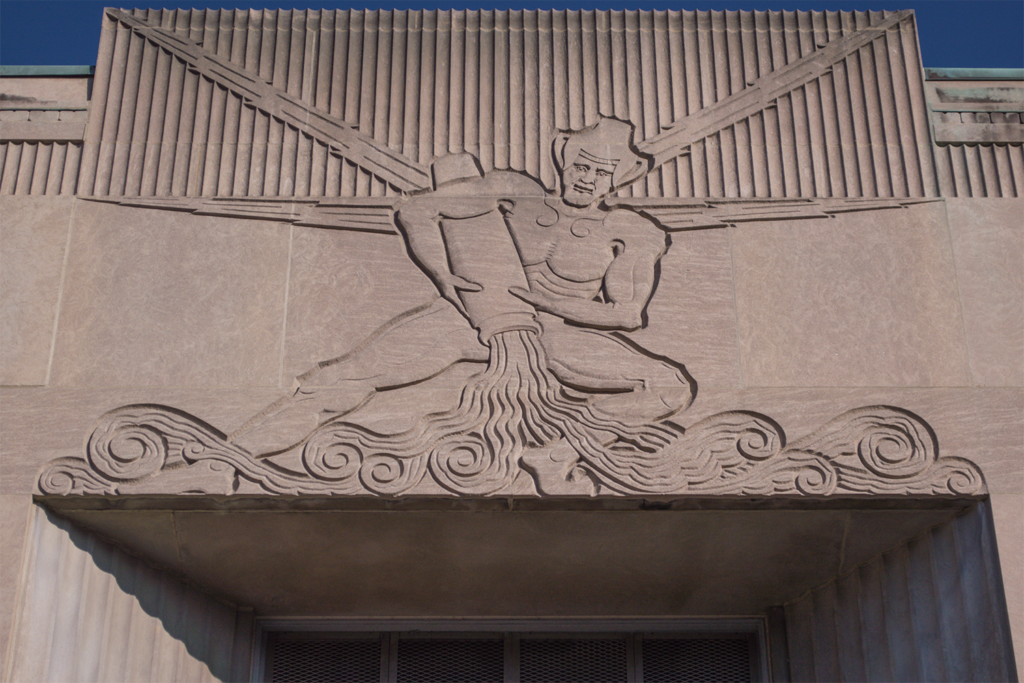
A single-story limestone Art Deco building, the Steinkamps went out of their way to make sure both the generation of their day and future generations would flock to marvel at its artistry for years to come. Metal-paneled Egyptian water carriers cap off elongated vertical glass block windows on the front and either side of the building; directly above the front door, a muscular, posed figure pouring a vase of water is beautifully etched into the limestone along with stylized lightning bolts and concave vertical lines that are commonly associated with that era’s design. There’s a miniature parapet surrounding the façade that splits at the stairs leading up to the front entrance. The entrance is a series of double doors encased in brown metal punctuated with lime highlights and dark, translucent windows embedded between vertical etched metal floral strips on either side. It sticks out like a bay window, both outside and in.
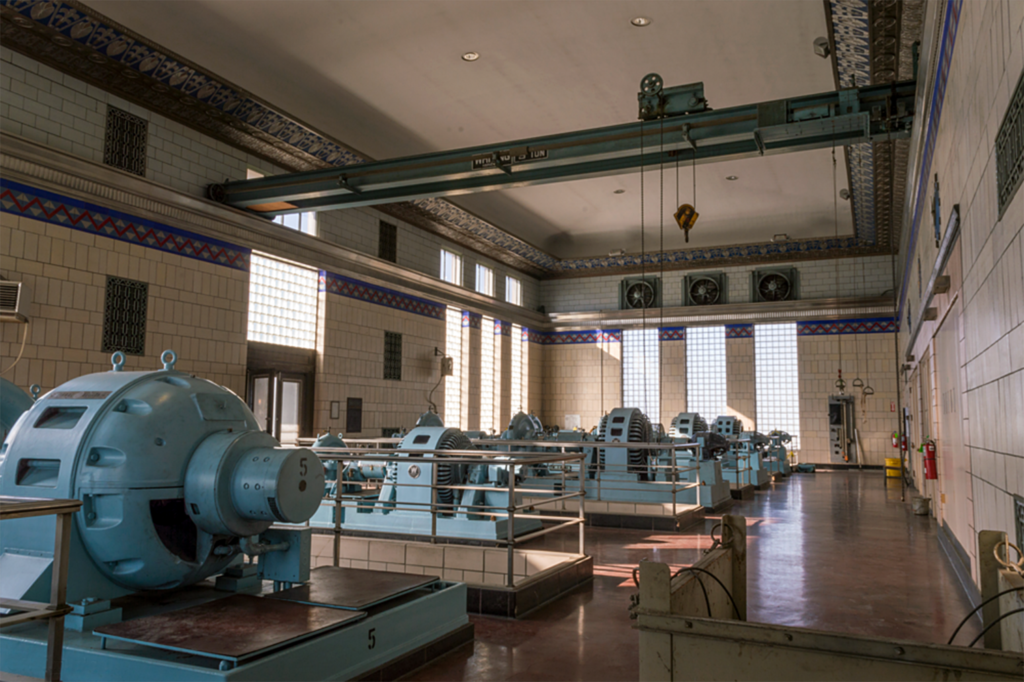
But the inside is why we were there.
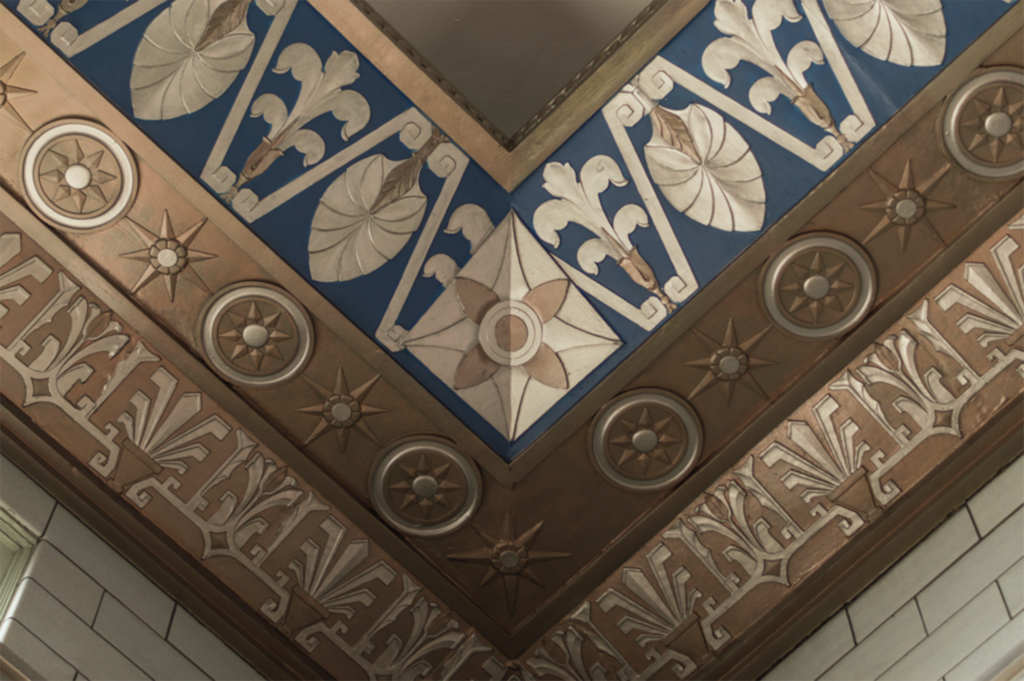
The thing that makes this building so amazing inside is how original everything seems. I’m not an engineer, and my perception of what’s original versus whats been updated is obviously not the final word but, to my eyes, it looked like it hadn’t been updated since it began operation. Ivory terracotta tile permeate the majority of the inside of the station’s main pump room, giving it that old elementary school look. Partway up the walls, a horizontal blue stripe of tile accented by white triangles and laced together with a red zigzag line divide the walls around the entirety of the room while underscoring metallic chrome trimming replete with a vertical design that resembles the edge of a quarter.
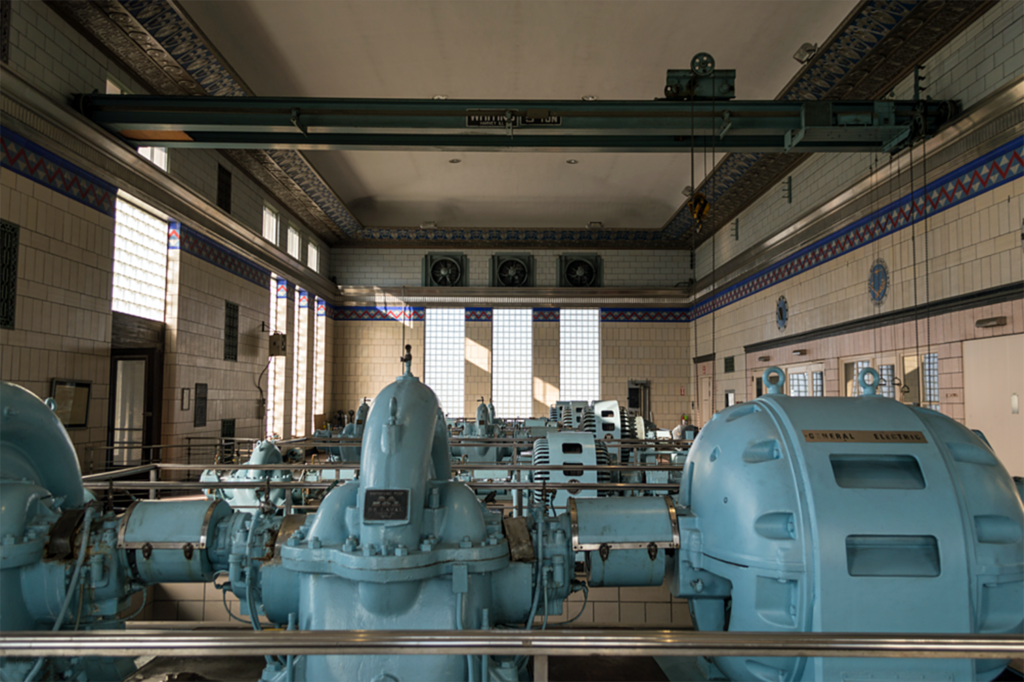
Where the ceiling meets the walls, shiny strips of ornamentation make a complete loop around the entire room. This perimeter design accepts the indirect light from the floor and releases it back out over the azure machinery below. It’s not embellishment to say that In the middle of the morning, the pump station is more than fully sated by natural light. The decorative strips appear to bear stars above stylized potted fire and plants between instances of large leaves, all separated by scroll-shaped lines that mirror the gates to the basement below. They’ve been painted gold and silver with a cornflower blue background to accentuate definition. The shapes in those colors truly are magnificent, especially since they’re repeated in a loop around the room.
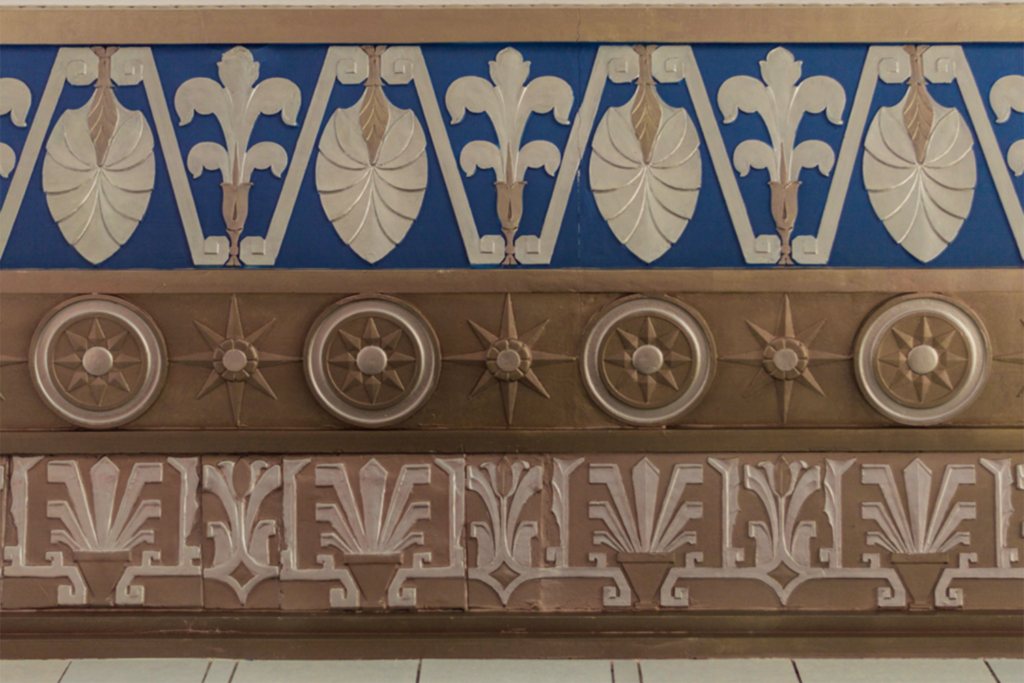
The quality of the pieces combined with the scope of it makes you appreciate it so much more. This is a pump station, not a courthouse or a personal home or an office building. The fact that the Steinkamps chose to include such lustrous adornments (for what is basically a machine warehouse) is hard to believe. Larry mentioned they’d pulled in several experts a decade before to repaint and restore these pieces and the ceiling to their former glory. Few people have seen the fruits of those restoration efforts, which blew my mind.

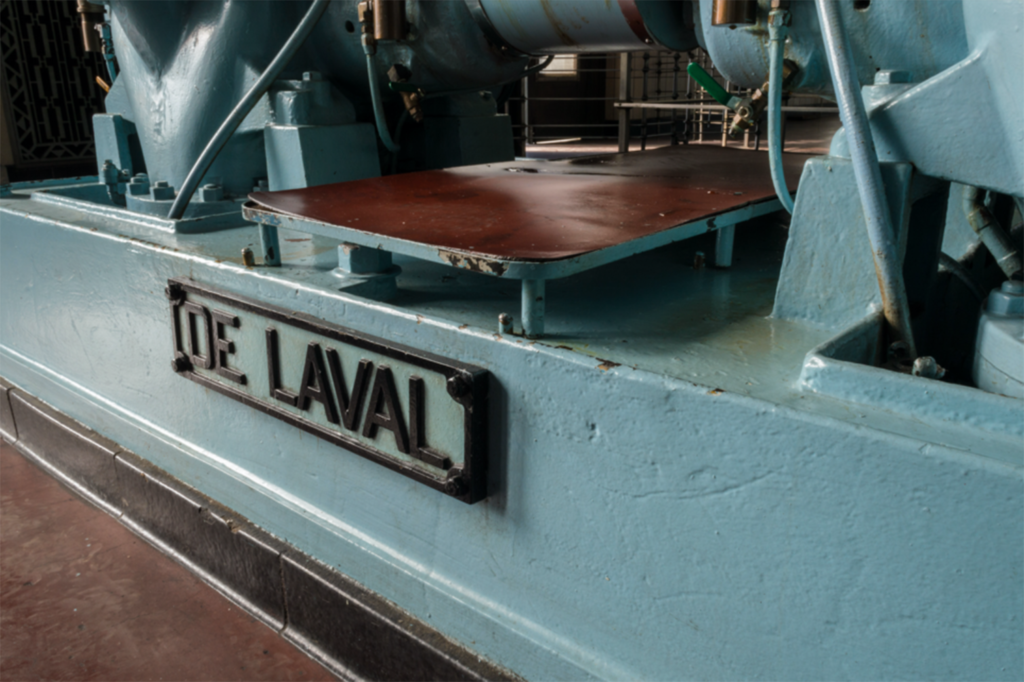
The room features five large pumps that constantly run, filling the room with a din that easily drowns out conversation unless you’re yelling to one another at close range. I got used to the sound after a few minutes, but talking to Matt was labored.

In the corner of the room sat an old, partially tattered map from 1962 of the Cincinnati region that was aged to a caramel color to which Matt was transfixed for an extended period of time (the photo of it was made black and white for clarity).
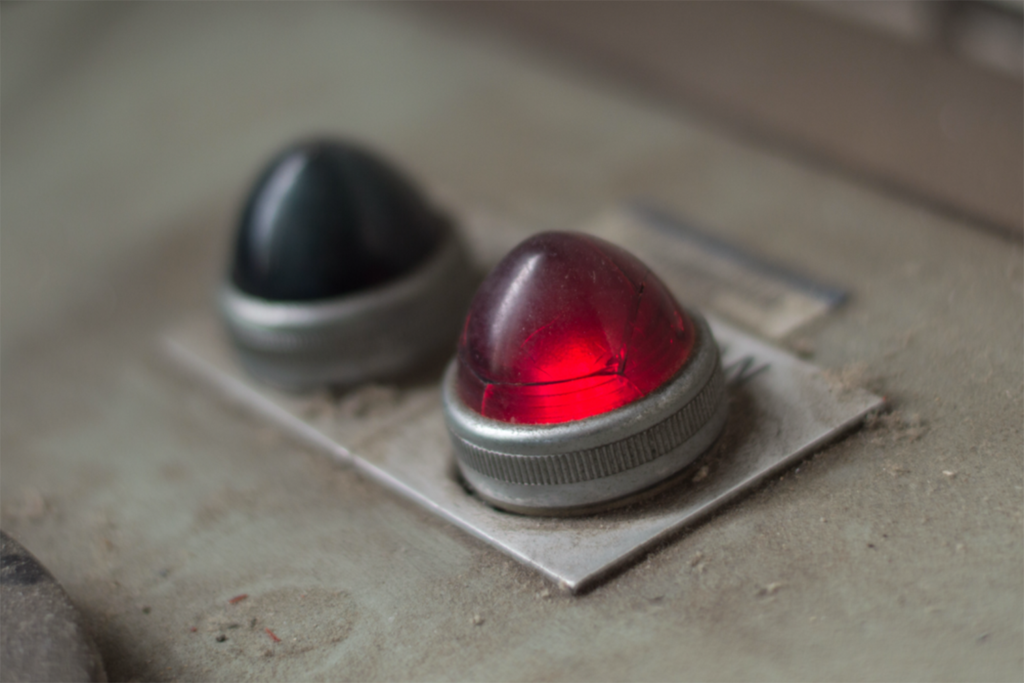
A dusty control panel sat next to it with dials and meters; I guessed it was an original piece of equipment from that era due to how stereotypically “thirties” it looked. I was asked not to post close up photos of the machinery and select piece of equipment due to national security concerns, which is why I cannot show you the full image of the control panel here.

Down narrow staircases on either side of the pump room sits a basement that’s filled to capacity with pipes and valves from over half a century ago. Little openings in the floor between the pumps guarded by railings on the main floor look down into the basement as well, giving it access to natural light, in addition to the fluorescent and incandescent lights installed between floors among spiderwebs of thin orange pipes.
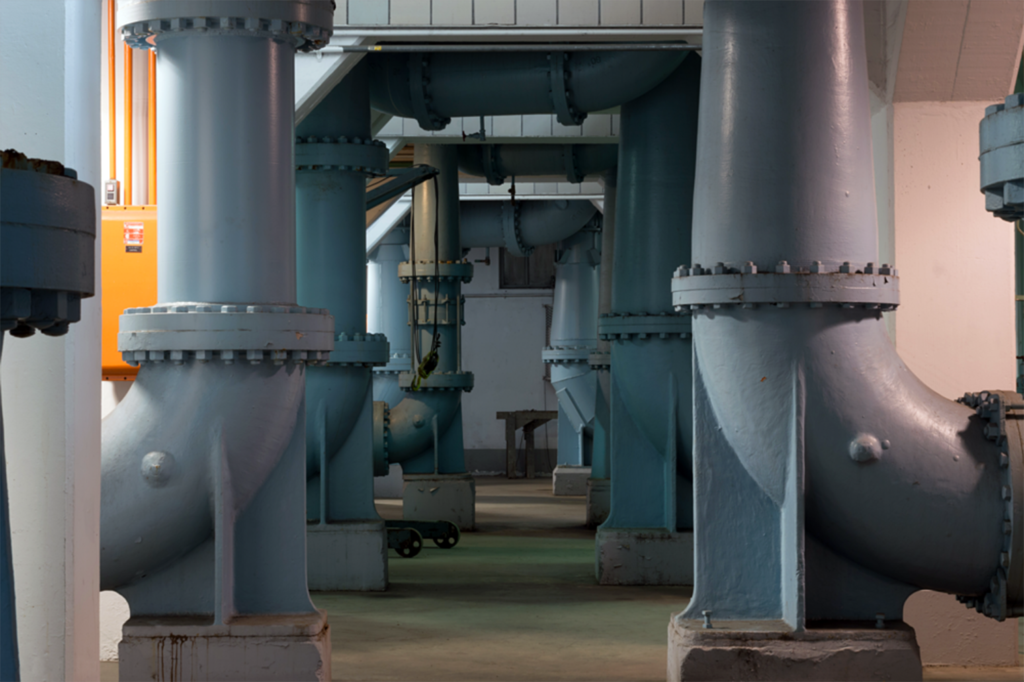
Everything looks to be in prime condition despite the age of the machinery; I wondered if it’s because the machinery and pipes are well-protected or because there’s an ongoing effort to keep them free of dirt and grime. Perhaps a combination of both. Regardless, it’s a lot cleaner than I’d originally imagined a pump station would be and it resembled an almost movie-like quality, like it was a recreation for a film set in the thirties.
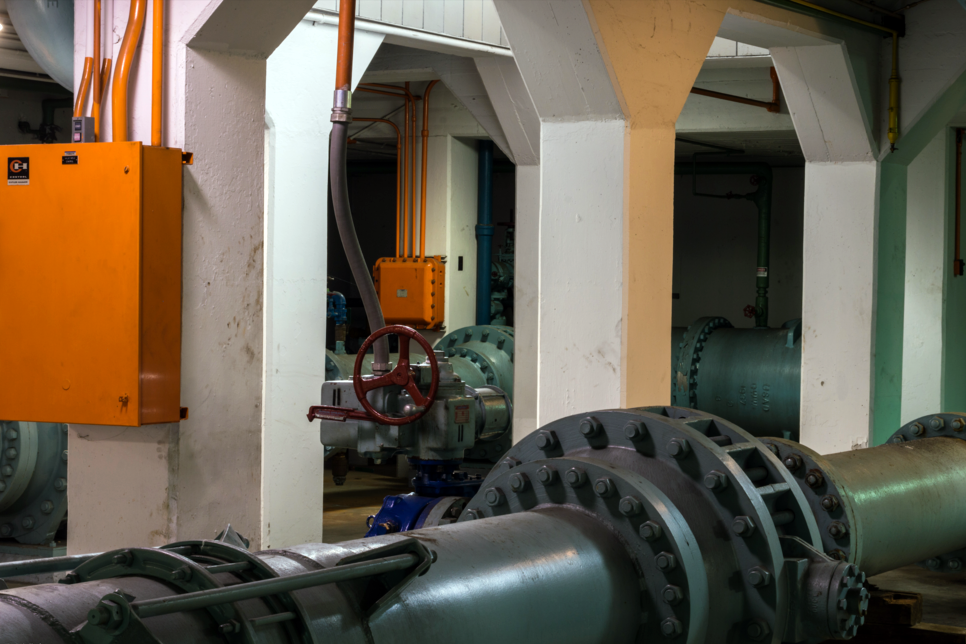
The basement also featured a very tiny “bomb shelter” that had been retrofitted as a bathroom. We take for granted the ability to live in a world where we don’t constantly worry about being killed by a nuclear explosion on our home soil, but people back then had that fear at the back of their minds and the architecture reflected necessary elements that made tangible their lingering anxieties. It was odd to be inside a tiny room expressly designed to resist such malevolent deeds; it made me wonder about Hiroshima and Nagasaki and how those people felt before and after their fears of being annihilated erupted into a horrible reality back in 1945.

The pump station was meant to subsist on a light staff and their well-being was taken into account by the Steinkamps’ blueprints from the beginning. Not only did the architects have to make the building functional, they chose to lavishly decorate it and include a tiny room solely for the purpose of protecting a few men from one of the worst catastrophes they could imagine at the time.

Matt and I spent about an hour in the station, taking tons of pictures and discussing the waterworks with Larry. As we left the station, I realized I’d probably never get to see the inside of it ever again. It made me sad that more people can’t readily see the brilliant Art Deco features and the old machinery inside the pump room with their own eyes, but I was happy that at least we were able to get in and document it as best we could in the limited time frame we were given.
That little moment in time on February 6th at ten in the morning was something I’ll never forget, because it inspired looking into the story of a relatively small building on a hill, just up the street from the viaduct, that has been dutifully pumping away for almost eighty years without stopping, making the lives of so many in the area better with a constant stream of fresh, clean water with little fanfare.
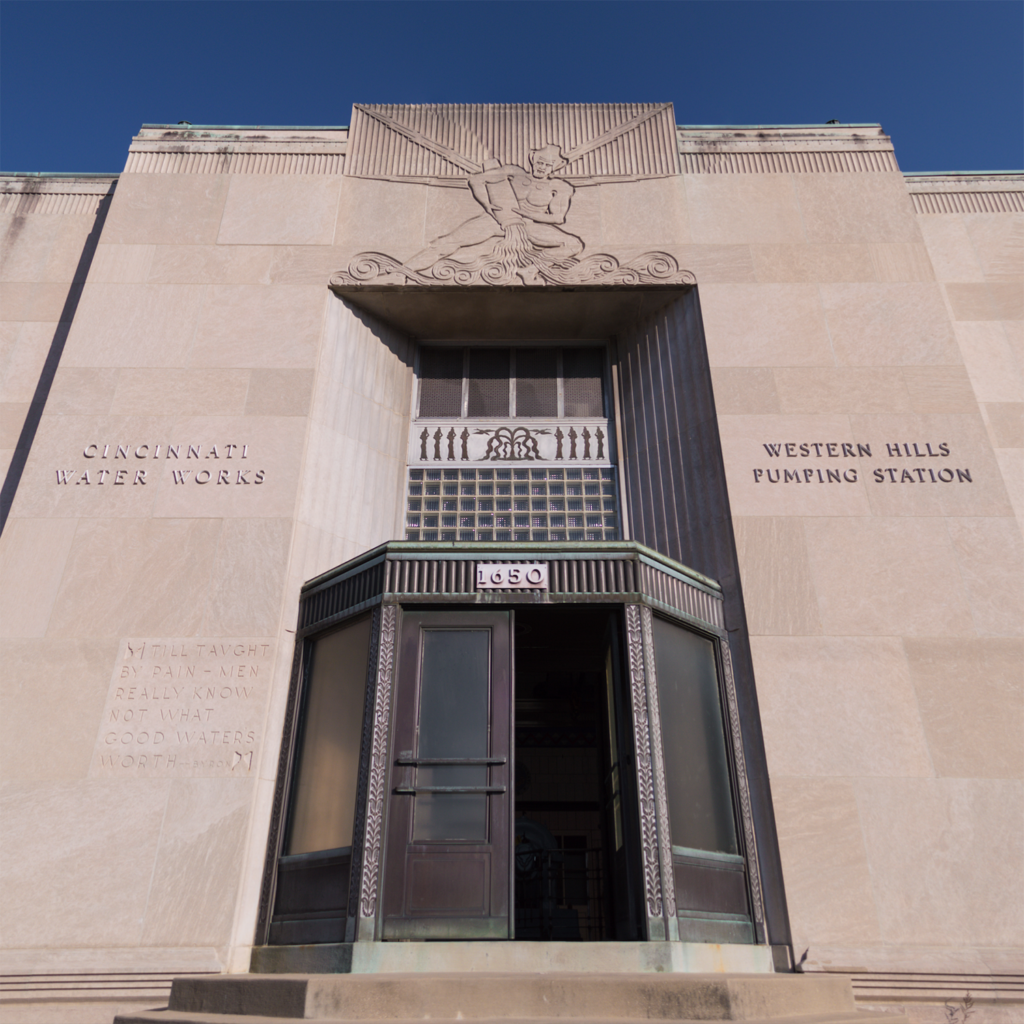
The bickering between management in the early thirties about steam versus electric pumps, the visionary brothers who created the blueprints, the seventy year old waterworks retiree who helped the city one last time, the fifty men who used their own hands to put it together, the WPA money that helped pay for materials and those fifty men a half-dollar hourly wage, and the soggy five minute speech the mayor gave before the heavens opened up above them one hot August day nearly two years after the station was opened and forgotten; it’s the humble story of the Western Hills Pumping Station, the most modern in the United States in 1937 and among one of the most beautiful preserved architectural relics in Cincinnati today.
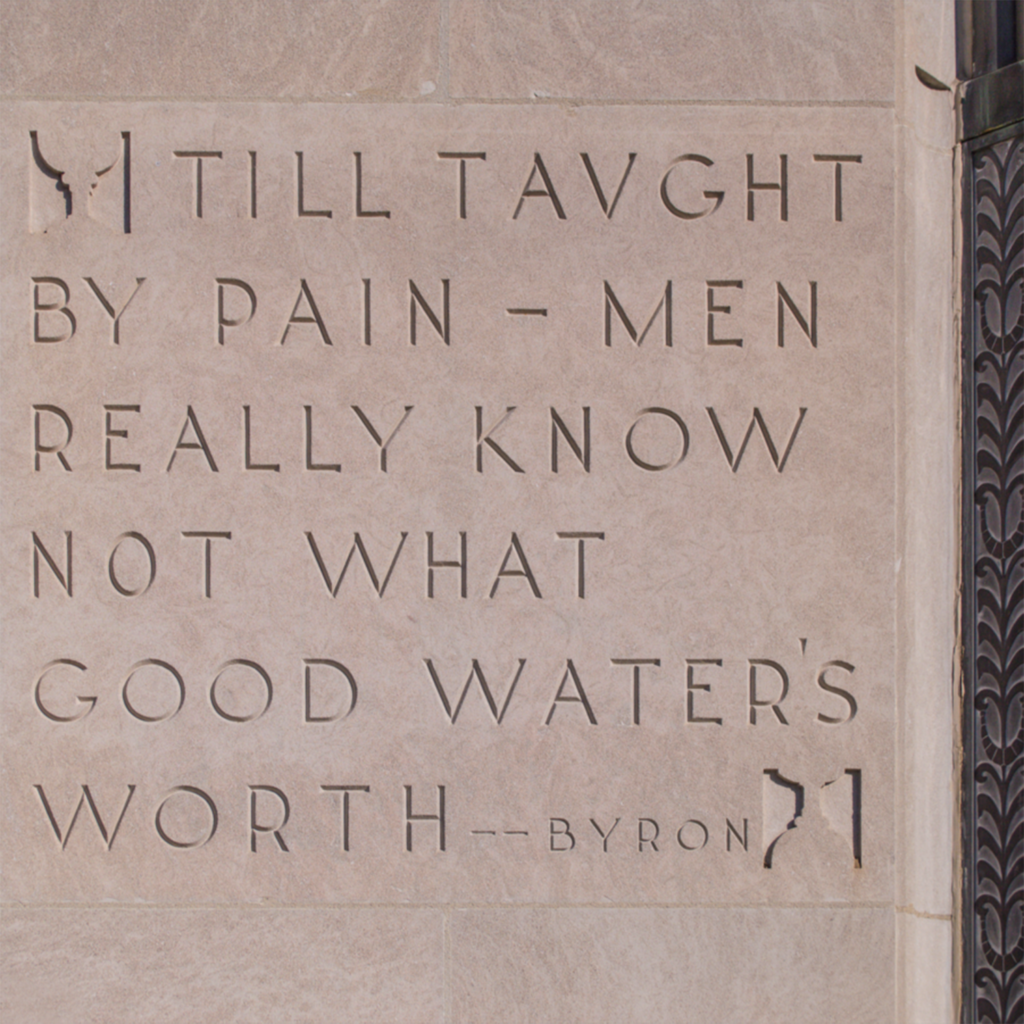
This inscription is a quote from Lord George Gordon Bryon, an English poet from the early 19th century, etched into the limestone on the left of the front entrance.
References:
- Plant Needs Expansion.” The Cincinnati Enquirer 21 Mar. 1930.
- “Steam Power Is Said To Be Cheaper.” The Cincinnati Enquirer 5 Apr. 1932.
- “Electrification Is Favored.” The Cincinnati Enquirer 15 May. 1932.
- “Steam Pumps Show Lower Expense.” The Cincinnati Enquirer 26 May. 1932.
- “Electric Pumps Planned For Station.” The Cincinnati Enquirer 23 May. 1934.
- “Engineers Hired By City.” The Cincinnati Enquirer 23 Nov. 1934.
- “Root Off With Projects” The Cincinnati Enquirer 10 Jul. 1935.
- “Western Hills Pumping Station.” Cincinnati Triple Steam. N.p., n.d. Web. 13 Feb. 2016.
- “To Accept New Pumping Station Today; Reported ‘The Most Modern in United States.’” The Cincinnati Enquirer 4 Dec. 1937.
- “Western Hills Dedicates Pumping Plant, Reopens Three Newly Improved Streets.” The Cincinnati Enquirer 5 Aug. 1940.
- “Tough On Love Birds.” The Cincinnati Enquirer 5 Sep. 1940.
- “Flywheels Loaned By City.” The Cincinnati Enquirer 22 Jan. 1942.
- “Pump House Is Sought In Petition.” The Cincinnati Enquirer 4 Jun. 1942.
- “Contract Is Awarded.” The Cincinnati Enquirer 8 Aug. 1942.
Phil Armstrong is a photographer and preservationist.
